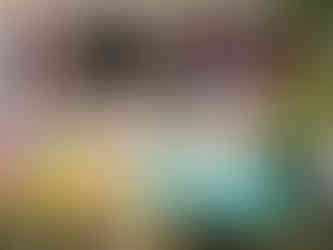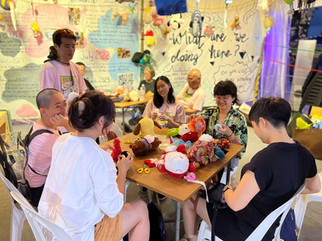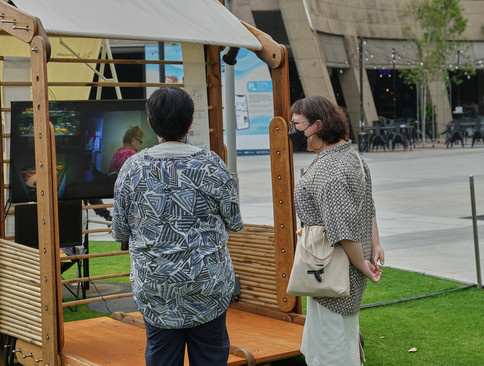Chaos to Order #2: A Dialogue with Jimmy and Shiyun on Kiap Kiap Revolution
- 3Pumpkins

- Mar 18, 2023
- 10 min read
Updated: Aug 2, 2023
Edited by Lin Shiyun
Introduction and Copyediting by Amanda Yeo
Interview supported by Lim Ci Xuan
Kiap Kiap Revolution: Re-Imagine, Re-Order, Re-Connect is a participatory art exhibition presenting a world of wacky mutant dolls that were manually reconstructed from bags and bags of claw machine stuffed toys donated to Tak Takut Kids Club (TTKC). These mutant dolls first appeared from a co-creation process in which artist Jimmy Ong prompted the children of TTKC to deconstruct all donated toys into loose parts, conjoin different parts and scrap material with safety pins, then finally guided each child to hand-sew their own composite “creature” or improvise upon other ones. Over the course of two years, almost every child in TTKC has picked up a threaded needle in the process of exercising their agency to imagine and create, while some also engaged in dialogue about normalcy and oddity. A troupe of mutant dolls that embodies individual creativity within a culture of imaginative play thus takes centrestage in Kiap Kiap Revolution.
The exhibition is set up as a carnival in an olden style of local pasar malam that occupied footpaths and void decks of neighbourhoods—it invites children and adults alike into the space to play together. Visitors can also find themselves a quiet spot in the ‘Studio’ area to experience the unique process of making their own mutant doll, or to simply spend time interacting with the creations on display.
In this dialogue, Jimmy and Lin Shiyun, 3Pumpkins-TTKC Founder & Executive Director, reflect on the entire co-creation journey that preceded the exhibition and what it entails to present the spirit of TTKC in a public setting.
'Kiap Kiap Revolution' is presented in the format of an interactive carnival.
'March On', Esplanade, 2023.
Photos by 3Pumpkins.
Shiyun: Let’s begin this conversation with the project title Kiap Kiap Revolution. We have gone through quite a bit of brainstorming for this, from the initial ‘Mutant Dolls’ to ‘Tak Takut Kiap Club’ and many more.
Jimmy: Ya, the title is beginning to come together. I’m seeing it as less about my work with the children, less about the output of mutant dolls and more about TTKC and how we can bring the intangible part of TTKC to share with the public.
Shiyun: What is this intangible part of TTKC?
Jimmy: Basically it’s about play and joy. I’m thinking the best thing we can share, especially during and post-Covid, is to export our joy, laughter and fun.
Shiyun: To me, TTKC is about holding a non-judgemental space and having close-knitted relationships. A kid can lie down and sleep in TTKC, because we recognise that as their current state of being and we first try to understand what contributes to it. Our relationships strengthen from this long process. But I think when it becomes a showing to the public, that’s when some things just can’t be transported over.
Jimmy: We need to be comfortable in our own skin and feel at home in a public venue. Based on my experience of our last March On exhibition, it was when L repeated his wet market-style jingle and the kids worked together at the merchandise table that their unique community identity became more evident in that public space.
Shiyun: The community identity was very strong.
Jimmy: Yes! And the kampong spirit was there, no need to explain too much.
Shiyun: I see the value of taking the kids out of their home ground to a public space to present a work that they’ve done in their own community. It really builds their community identity. This is something that cannot be achieved in Boon Lay because they see themselves in a familiar setting there everyday—
Jimmy: —they need to put themselves out there. Like how the Chingay Parade used to be when it was done in the heartland neighbourhoods. You know which temple and cultural groups are coming, and the joy was walking from this landmark to another landmark in the neighbourhood.
Shiyun: From our last March On exhibition, I was trying to understand what public presentation does for the children. How did they behave differently? Did any part of themselves change or not change? I learnt that after they had been put in the role of a docent to introduce visitors to TTKC and their own artwork, that experience became a core memory for them later on. They recall that people want to know about them, hear from them, and are interested in their stories.
3Pumpkins’ presentation of ‘This is What We Eat at Home’, a photography exhibition featuring stories of TTKC children and youth.
'March On', Esplanade, 2022.
Photos by Marc Nair and 3Pumpkins.
Shiyun: Speaking of stories, let’s talk about how this project began in TTKC for you and the kids.
Jimmy: The project started with prototypes of mutant dolls. One day, there were many toys lying around, specifically a set of teddy bears which the kids were using for pillow fights. That moment I stopped them by saying “Let’s cut them all up”, so they cut the teddy bears up. There is something about the boys’ urge to destroy which was wonderful, and they were given permission to do so. After that, I pushed H to assemble all the cut-up parts back together as a new toy. What I intended to make was the character of Ravana who is multi-headed for the story of Ramayana. And that’s how we have the first mutant doll.
Shiyun: That was close to the end of 2021. Even before that, in June 2021, you guided kids to sew, and the kids who ended up sewing with you were the most unusual suspects. Your first sewing club actually consisted of mostly boys.
Jimmy: Yep, it was more like a challenge. I tried to challenge them that boys can sew too, not just girls. It did take a long time for them to start doing it as most of their initial reactions were like “Ew, I don’t want to do sewing, it’s for girls”.
Shiyun: You also introduced the use of the sewing machine as if driving a car. That really sent some of our staff screaming and tearing their hair out. We had to send all the machines for servicing after two months. Hahahaha.
Jimmy: Iski was always coming to me wanting to play. He would switch on the sewing machine when I had switched it off, or he would try to sew himself. It was quite dangerous so I needed to guide him so that he could sew without endangering himself. We simply used fabric and he did the motion of turning. That was when we made lion dance costumes too.
Shiyun: So from the pillow fight transitioning to this intervention with Iski, it was about channeling a very high energy which could be damaging to not just the self but others, into something creative.
Jimmy: I tried not to tell them “no you cannot do this”. Instead, everyone got an opportunity to play with the sewing machine. Eventually, the colourful lion dance costume had every kid’s effort of sewing, almost everyone worked on it.
Jimmy takes on different sewing activities with boys who were initially reluctant to sew.
Tak Takut Kids Club (TTKC), July 2021. Photos by 3Pumpkins.
Shiyun: This happened sometime in July or August 2021. After that, during the year-end holidays and centre closure, that was when donations of claw machine toys started coming in because people were clearing out storage or thought that kids wanted them for Christmas.
Jimmy: We didn’t expect those donations. But the kids did take some of the toys and the leftover ones were the uglier toys and misfits that nobody wanted. So that was when I started cutting them up and conjoining loose parts from different toys.
Shiyun: From then on, did the involvement of the children also change?
Jimmy: Yes. HN is someone who didn't have lots of patience to sew, but she loved to pass by and give comments. So I started asking for her opinion like: “Is this ear good enough for the elephant? Should it be longer? Where should the eye be, here or here? Can you mark the spot where the button should be?”. So she became a source of direction, and that’s how I learnt to invite the children to participate even if they were not sewing.
I remember there was a particular doll which had many problems, it was growing big and becoming many things, and at last it could fit in a child’s swimsuit so it became a fish. That’s when the “mutants” started.
Shiyun: Oh! I know exactly which fish that is, the light blue one with a Minion. I think the most precious and unique thing about this whole process was that you were simply having fun creating from what was available in the community and learning how to engage with children. You were making the dolls without any objective of showing them or working towards a presentation.
Jimmy: We made about 50 dolls.
Shiyun: And the idea for this project as it is called now, Kiap Kiap Revolution, didn’t happen until much later.
Jimmy: It came much later, though I was mindful that we could sell these dolls for our fundraiser but that didn’t happen because we were short on time.
Shiyun: That was December 2021 or January 2022 so yes it was our fundraiser period. After that, you took a break from TTKC.
Jimmy: I went to America, and when I came back the focus was on developing Getai already. The sewing of dolls was put away. I started making big costumes, like the crab costume that Farez put on and walked in at the playground with many kids following behind. These costumes were a device for interaction as new kids could easily make them with little support. I was constantly thinking of ways in which new kids could extend themselves to play.
Shiyun: The invitation to play is important. I find that in my interactions with the kids, making something that is weird-looking is not natural to them. Only a few kids would be immersed in the process of re-ordering: joining body parts together to make something that looks new. Quite many would want to repair the dolls, which is very reflective of the culture and systems they grew up with.
Jimmy: Do you think it is reflective of their personal character as well?
Shiyun: Maybe it is. And it’s also exposure. If children are exposed to environments where adults want order and things are in order, they would tend to want to put things in order. So when you switch a supposed order around, it becomes weird for them. They need a bit of warming up to this new thought process.
Jimmy: Then we are a relief to what schools train us to become: orderly and perfect. When they saw us cutting those toys up and making something funny…
Shiyun: …the first question was always “Why?”, “Why are you cutting this up?”, to which we would reply “Oh, we’re just playing, for fun”.
Jimmy: But once they got over this initial barrier, they were quite willing to cut the toys up and wanted to continue doing so. There was this one girl who was reluctant at first, saying she wanted to keep the toy intact and didn’t want to do anything to it, but later when I showed her how, she quickly said “Okay let me cut for you!”. So I think we are daring them to break conventions, to paint outside the line.
The mutant dolls made by Jimmy and TTKC are up for auction with a starting bid of $20 each. All proceeds go towards supporting 3Pumpkins’ community art development programmes.
Photos by 3Pumpkins.
Shiyun: Going back to the very beginning when you said you are starting to feel more for the project title Kiap Kiap Revolution, I think we can expand more on what the “revolution” means?
Jimmy: I think the revolution is showing to other children and to ourselves first, that we don’t need to spend money to have entertainment. We are highlighting the essence of playing, especially against the capitalist notion of spending money to buy gifts and to gamble.
Shiyun: I have never really associated the claw machine with gambling, but indeed it is a form of gambling.
Jimmy: Yeah, you can get addicted, you want more. You would want to try and win something everyday to bring home, so there is also the sense of a hunter's mentality. Everyday I will bring home some game, and if I fail to “bring back a fish”, I go home embarrassed.
Shiyun: Sometimes I would bring my son to local carnivals. The games are really expensive, at least $3 per game.
Jimmy: The more traditional kampong-style carnivals are about the spirit of family outings or having fun with your own tribe. Not so much about going there to win something and go home, or when kids gather to brag about how many points they have scored.
Shiyun: One of the very important yet intangible things about TTKC is that we value fun. Kids like to come here because it’s fun and the adults are funny. If it’s not funny they won’t come here anymore. I often think this may be the downfall of our programmes in educational and social support for kids. How are you going to explain and evaluate the importance of being funny? How do you plan for and strategise funny? So we stopped being funny. It’s sad for the children and I hope it doesn’t happen to TTKC.
Jimmy: I know. In Singapore there are not many places with humour. I think children love to see adults who are vulnerable and don’t strive to be perfect.
Shiyun: This is one of the things we have to consider when the work is presented outside TTKC. How do we inspire other adults to co-create this funny and fun-loving environment, which is essentially the spirit of TTKC?
Jimmy: Yes, I think if we ourselves, the adults of TTKC, retain our own childlikeness, then other adults might see that there is nothing wrong about appearing silly and not having all the answers. I don’t know what we will do but whatever we do, as long as we have joy and fun, that may be the revolution we need.
The adults and children of TTKC in an excited state with a fresh batch of donated stuffed toys.
Tak Takut Kids Club (TTKC), January 2023. Video by 3Pumpkins.
THE MAKING OF KIAP KIAP REVOLUTION: A TIMELINE
Some time in 2020...

2020 marks the height of the Covid-19 pandemic
Artist Jimmy Ong is unable to return to his residence in Yogyakarta
He joins the TTKC community as an artist-in-residence
Known as “Uncle Jimmy”, he engages with the children through drawing
June 2021

Uncle Jimmy introduces sewing sessions to the children using scrap fabric
The first children to sign up are a few boys who wanted a go at the sewing machine
Their initial creation is a lion dance costume
August 2021

Inspired by Hungry Ghost Festival, Uncle Jimmy initiates shadow puppetry
The TTKC community creates puppets for their weekly 'Getai' showcases
November 2021

TTKC is inundated with gifts that the public thinks the children need or want
Soft toys acquired from claw machines are the most popular donations
As it turns out, the children don’t need these things
December 2021 – January 2022

The sewing boys have a pillow fight with the donated toys and parts go flying
Uncle Jimmy suggests, "Shall we just cut them all up?"
A “monster toy” is born out of several teddy bears
More mutants follow as new characters for laughs
Uncle Jimmy and the children develop the “Kiap Kiap” method: toys are deconstructed and put together with safety pins in ways that create completely new characters
Over time, the children upend their roles as beneficiaries and make more than 50 mutant dolls
July 2022

The “Kiap Kiap” process generates important conversations about matters like charitable giving, social dynamics and the environment
Esplanade invites 3Pumpkins to participate in March On 2023
August 2022 – February 2023
The Kiap Kiap Revolution continues
Photos by 3Pumpkins
Join us in the Kiap Kiap Revolution at Esplanade Courtyard from 17-19 March 2023, 5-9pm.
See you there!



































Comments